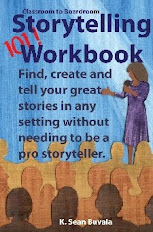The essentials of storytelling remain the same regardless of where you are using storytelling.
I often get requests via Email or telephone that are similar to something like this:
"I work in the (fill-in-the-blank) industry. Can you teach storytelling to my staff in my (fill-in-the-blank) industry?"
The answer is always yes. The essentials of "how to tell a story" do not change regardless of the industry in which you want to use storytelling. You name it: health care, education, politics, nonprofit, business, marketing, entertainment, sacred- the essentials of storytelling remain the same. I've taught storytelling in those niches and even in some more unusual niches, such as the mining industry. That's right, some people who dig deep into the earth learned storytelling for their work from me.
In any setting, these 5 essentials of story always apply:
1. You must be audience focused.
Before you speak to any group, you need to know what they need from you. Simply repeating the same stories over and over again for different audiences is self-indulgent. Although I may use some of the same stories from group to group, how I tell the story and which parts of the story I tell changes with each audience. There is no such thing as canned storytelling.
2. All storytelling must use the components of beginning, middle and end.
A story must start somewhere. The story then has tension or issue in the middle. At the end of the story, there is some type of finality or resolution. An anecdote may have just one or two of those parts. A mix of storytelling and anecdote may be what your audience needs to hear. Remember, an anecdote is a moment in time. A story is a complete experience.
3. All stories must be broken into episodes.
In any industry, your stories should not be viewed as a one-perspective masterpiece but rather as an image that changes based on where the audience sheds their light. Break your story into episodes, determine which episodes are the "core story" and then add or subtract the other episodes as needed. Life looks different at dawn than it does at noon- both in reality and in metaphor.
4. You need to use good public-speaking mechanics.
Whenever you speak, you need to be heard. You need to know what to do with your hands and gestures. You need to enunciate. A good storytelling coach can help you master your storytelling techniques and your presence.
5. You need to blend personal and world-tales together.
In many industries, an audience grows weary of too many self-referential tales. They also might doubt your professional experience if all your stories are "once upon a time" folktales. Work to make your presentations a blend of stories form multiple sources.
Storytelling helps you to achieve your goals in all industries, markets and businesses. Use storytelling to advance the work of the industry of which you are a part. As a storytelling coach, I have helped many people go past story theory to the fun and effectiveness of successfully telling stories. Let me know if I can assist you.
*******
The official blog for K. Sean Buvala, storyteller and storytelling coach. ©2010 Sean Buvala
Subscribe to:
Post Comments (Atom)





These are great tips. Thanks. As I read I found myself going through a recent podcast story I did about my geriatric rooster, thinking "Check. Check..."
ReplyDelete